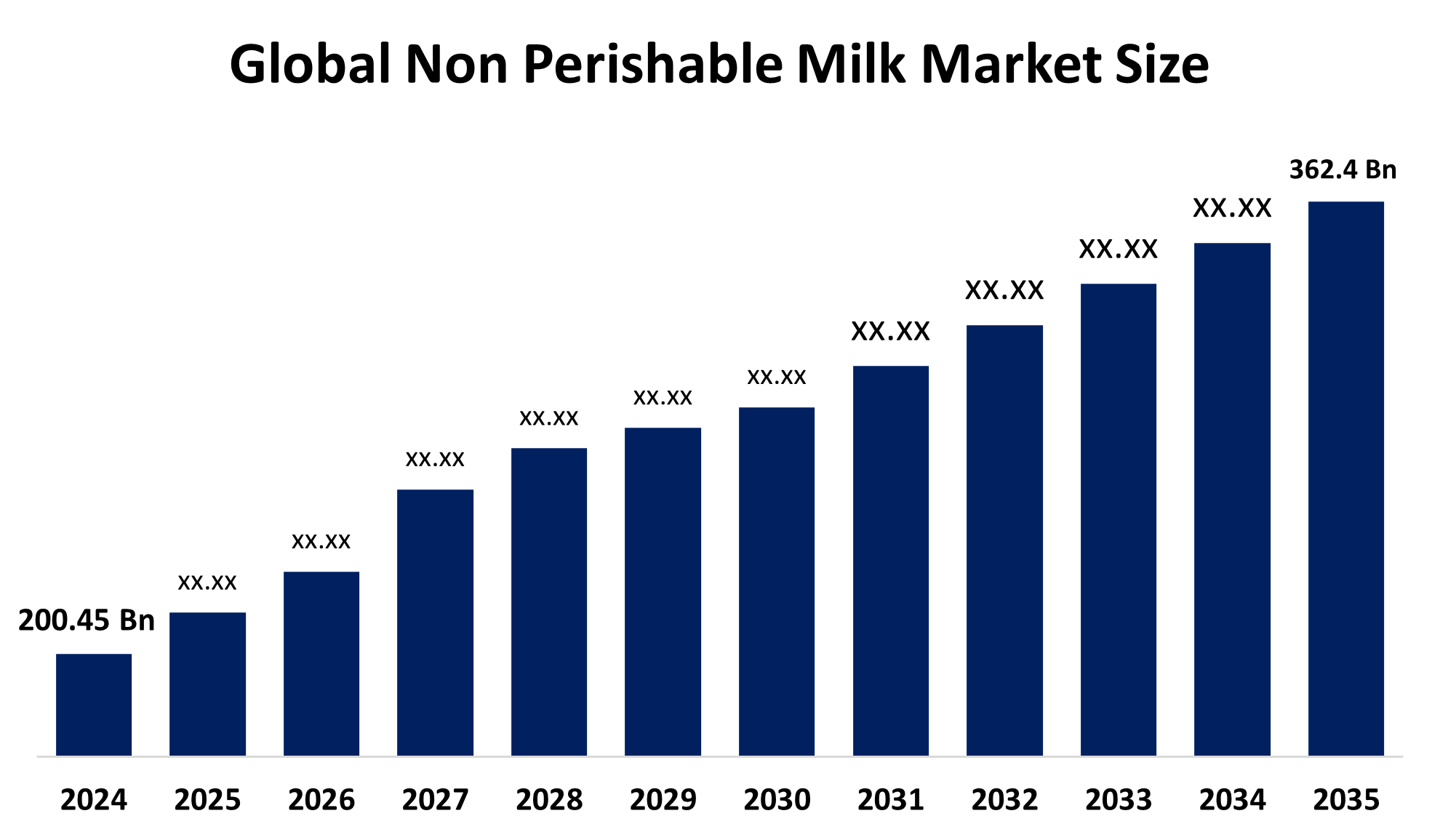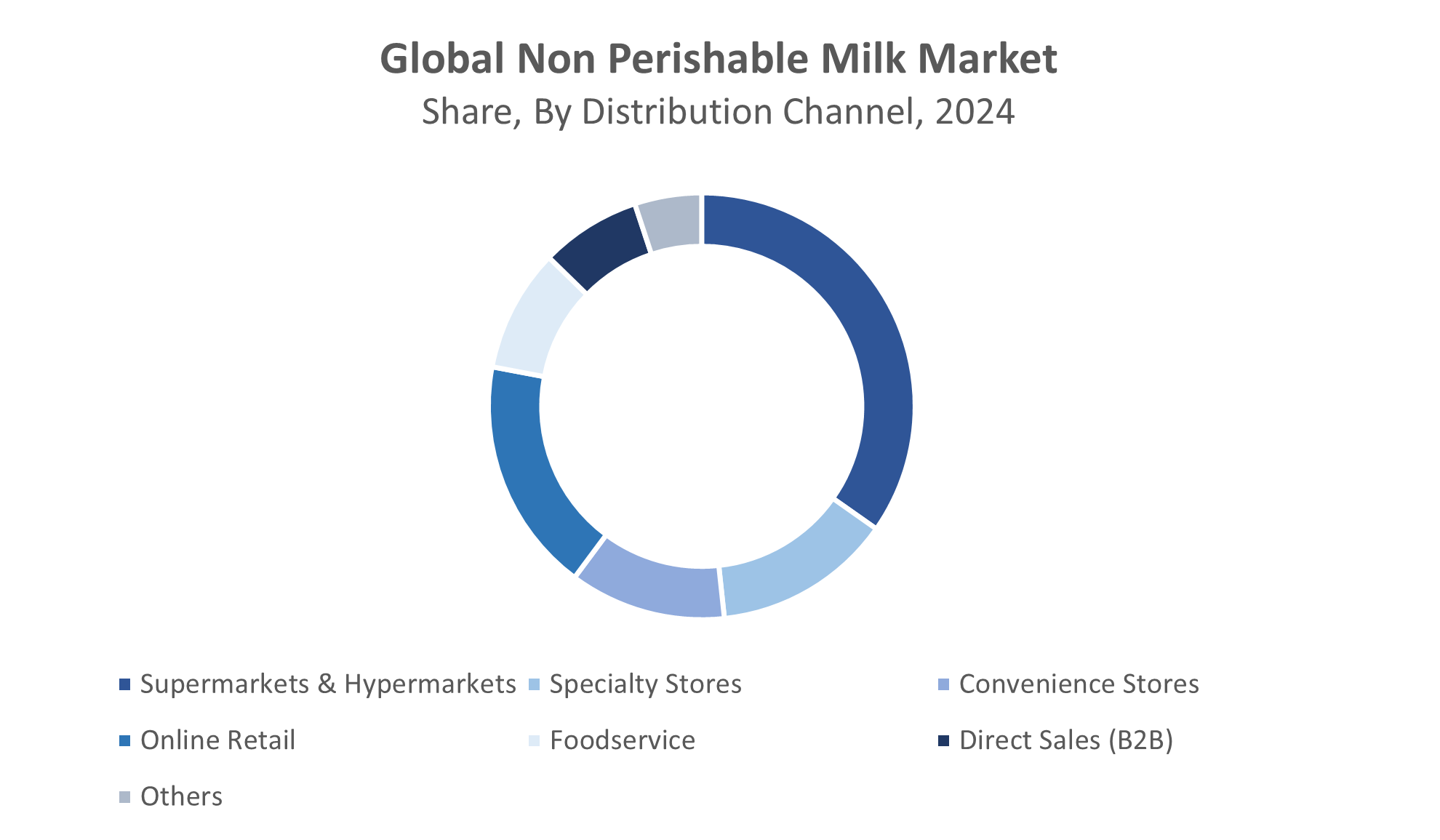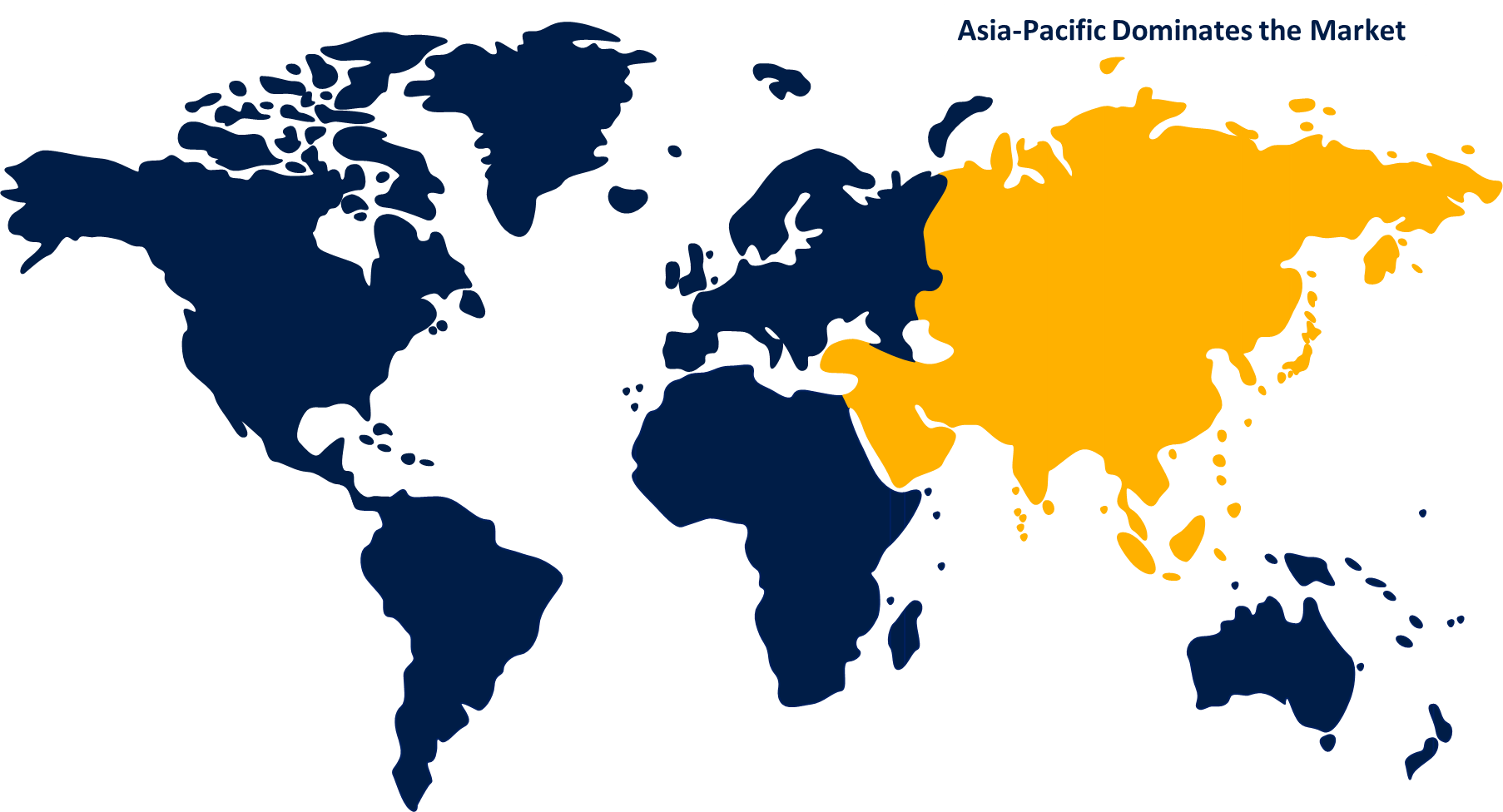Global Non Perishable Milk Market Size, Share, and COVID-19 Impact Analysis, Russia-Ukraine War Impact, Tariff Analysis, By Product Type (UHT Milk, Evaporated Milk, Sweetened Condensed Milk, Powdered Milk, and Others), By Distribution Channel (Supermarkets & Hypermarkets, Specialty Stores, Convenience Stores, Online Retail, Foodservice, Direct Sales (B2B), and Others), and By Region (North America, Europe, Asia-Pacific, Latin America, Middle East, and Africa), Analysis and Forecast 2025 - 2035.
Industry: Food & BeveragesNon Perishable Milk Market Summary, Size & Emerging Trends
According to Spherical Insights, The Global Non Perishable Milk Market Size is Expected To Grow from USD 200.45 Billion in 2024 to USD 362.4 Billion by 2035, at a CAGR of 5.53% during the Forecast Period 2025-2035. Increased demand for UHT and powdered milk as a result of urbanization, improved packaging technologies, growth in new markets, and fortified products for customers who are health-conscious creates opportunities for the non perishable milk market.

Get more details on this report -
Key Market Insights
- Asia Pacific is expected to account for the largest share in the non perishable milk market during the forecast period.
- In terms of product type, the UHT milk segment is projected to lead the non perishable milk market in terms of equipment throughout the forecast period
- In terms of distribution channel, the supermarkets & hypermarkets segment captured the largest portion of the market
Global Market Forecast and Revenue Outlook
- 2024 Market Size: USD 200.45 Billion
- 2035 Projected Market Size: USD 362.4 Billion
- CAGR (2025-2035): 5.53%
- Asia Pacific: Largest market in 2024
- North America: Fastest growing market
Non Perishable Milk Market
The global industry that produces, distributes, and sells milk products that have been treated to increase shelf life without requiring refrigeration before opening is known as the non perishable milk market. To ensure stability without cold storage, these products go through specialist processing to get rid of bacteria that cause spoiling. The shelf life of UHT milk is extended for months or years by pasteurizing it at high temperatures and dehydrating powdered milk to eliminate moisture. This market provides a wide range of applications, such as retail, food service, and industrial use, and serves both urban and rural clients, especially in areas with inadequate refrigeration infrastructure. Long-lasting dairy products are becoming more and more popular, which has greatly boosted the non perishable milk market. The industry is expanding steadily due to changing customer preferences and rising demand for dairy products with extended shelf lives. Increased self-sufficiency in dairy products, especially UHT milk, is intended to provide a steady supply for the home market and thereby signal a rise in demand on the international non perishable milk market.
Non Perishable Milk Market Trends
- Growing Demand in Emerging Markets: In developing nations, the lack of adequate refrigeration facilities and growing urbanization increase demand for powdered milk and UHT, propelling market expansion.
- Technological Developments in Packaging: Aseptic and environmentally friendly packaging innovations increase shelf life and portability, which boosts customer convenience and market share.
- Growth of Enriched Products: To meet nutritional needs, non-perishable milk enriched with vitamins and minerals is becoming more and more popular as health consciousness rises.
- E-commerce and Retail Growth: Expanding online and structured retail channels improve accessibility and facilitate market growth, especially in metropolitan and semi-urban regions.
Non Perishable Milk Market Dynamics
Global Non Perishable Milk Market Report Coverage
| Report Coverage | Details |
|---|---|
| Base Year: | 2024 |
| Market Size in 2024 : | USD 200.45 Billion |
| Forecast Period: | 2025-2035 |
| Forecast Period CAGR 2025-2035 : | 5.53% |
| 2035 Value Projection: | USD 362.4 Billion |
| Historical Data for: | 2020-2023 |
| No. of Pages: | 220 |
| Tables, Charts & Figures: | 110 |
| Segments covered: | By Product Type, By Distribution Channel, By Regional Analysis |
| Companies covered:: | Nestlé, Fonterra, Danone, Arla Foods, Friesland Campina, Lactalis International, Local/regional cooperatives, and Others |
| Pitfalls & Challenges: | COVID-19 Empact, Challenge, Future, Growth, & Analysis. |
Get more details on this report -
Driving Factors: Urbanization drives demand for non-perishable milk.
Demand for handy, long-lasting goods like powdered milk and UHT is rising due to urbanization, which is driving the non perishable milk market. Adoption is fueled by emerging economies' inadequate refrigeration infrastructure, especially in rural locations. Product shelf life and portability are improved by technological developments in processing and packaging, driving non perishable milk market expansion. The demand for fortified non-perishable milk with extra nutrients is driven by growing health consciousness. Product accessibility is increased through the expansion of retail and e-commerce channels, while consumption is stimulated in developing nations by rising populations and disposable incomes. Furthermore, powdered milk's adaptability in food processing and emergency food supplies supports non perishable milk market growth.
Restrain Factors: High costs limit non-perishable milk affordability.
The market for non-perishable milk is restricted by factors including high production and packaging costs, which make it less affordable in areas where consumers are price-sensitive. The preference of consumers preferring fresh milk over powdered or UHT varieties restricts uptake. Growth is hampered in developing markets by a lack of knowledge about fortified products. Market expansion is further restricted by environmental concerns over packaging waste, especially in areas where sustainable practices are valued.
Opportunity: Non-perishable milk market exhibits strong growth.
Strong expansion opportunities are shown by the non-perishable milk market, which includes UHT, powdered, condensed, and evaporated milk. Demand is driven by urbanization and a shift in customer tastes toward handy, long-lasting dairy products, especially in the Asia-Pacific. Product quality and accessibility are improved by technological developments in processing and packaging. Varieties of fortified milk cater to nutritional requirements and appeal to consumers who are health-conscious. Government initiatives that encourage dairy self-sufficiency in countries like China and India increase domestic supply chains and opportunities for export, which propels steady worldwide market growth.
Challenges: High costs challenge affordability in price-sensitive markets.
Price-sensitive markets may find it more challenging to afford UHT and powdered milk due to their high manufacturing and packaging costs. The cost of operations is raised by strict regulatory standards and compliance requirements. Distribution efficiency is hampered in emerging regions by inadequate cold chain infrastructure. A challenge is the consumer preference for fresh milk versus processed varieties. Concerns about sustainability and packaging waste may also turn off environmentally conscientious buyers, which could impede industry expansion.
Global Non Perishable Milk Market Ecosystem Analysis
The ecosystem of the global non-perishable milk market is made up of interdependent stakeholders. Dairy farms provide raw milk to companies like Nestlé and Danone, which use powdering and UHT technologies to ensure shelf stability. In Europe and the Asia-Pacific, distributors make sure that goods are delivered efficiently to merchants, e-commerce sites, and institutional buyers in response to urban demand. Safety and quality requirements are enforced by regulatory agencies, and nutritional needs are met by developments in fortified products. Eco-friendly solutions are required to address sustainability issues, such as packaging waste, to sustain market expansion.
Global Non Perishable Milk Market, By Product Type
The UHT milk segment led the non perishable milk market, generating the largest revenue share. Ultra-high temperature processing meets convenience and health standards by removing dangerous bacteria while maintaining flavor and nutritional value. UHT milk is a major growth driver owing to its steady performance in preserving flavor and freshness over extended periods of time, which has guaranteed ongoing consumer demand.
The powdered milk segment in the non perishable milk market is expected to grow at the fastest CAGR over the forecast period. The long shelf life, simplicity of storage and transportation, and growing need for powdered milk in a variety of industries, such as emergency assistance, food processing, and newborn nutrition, are its main drivers. Its attractiveness in international markets is increased by its adaptability.
Global Non Perishable Milk Market, By Distribution Channel
The supermarkets & hypermarkets segment held the largest market share in the non perishable milk market. The broad availability of a large range of product offers, competitive pricing, and the ease of one-stop shopping are the reasons behind the supermarket and hypermarket industry. A large variety of non-perishable milk products are readily available to customers in these retail formats due to robust supply chain networks and well-planned shelf positioning.

Get more details on this report -
The Online retail segment in the non perishable milk market is projected to register the fastest CAGR. Growing internet penetration, growing consumer preference for convenience, and the suitability of non-perishable milk for e-commerce logistics are the main drivers of the online retail market.
Asia Pacific is expected to account for the largest share of the non perishable milk market during the forecast period.

Get more details on this report -
The demand for shelf-stable products like UHT and powdered milk is being driven by the Asia-Pacific region's fast urbanization, rising disposable incomes, and large populations in nations like China and India. Growing nutritional awareness and supportive government policies encouraging dairy production and self-sufficiency support market expansion and place the Asia-Pacific region.
India is experiencing steady growth in the non perishable milk market. India's non-perishable milk market is expanding steadily. In the face of inadequate cold chain infrastructure, demand for UHT and powdered milk is rising due to government programs like Operation Flood and growing urbanization. Consumption is further increased by growing disposable incomes and nutritional knowledge in the market.
North America is expected to grow at the fastest CAGR in the non perishable milk market during the forecast period. Growing consumer desire for easy-to-store dairy substitutes and growing public knowledge of lactose intolerance and health issues are the main factors driving North America's rise. Additionally, product accessibility throughout the region is being improved by developments in distribution networks and packaging technologies. The market is growing as a result of non-perishable milk becoming more widely available through retail and internet channels.
United States is the largest market for non perishable milk. The United States is the biggest market for live fish. Strong customer demand for high-end goods like live UHT milk and crabs, bolstered by sophisticated distribution networks and a thriving seafood import industry, is what propels its rise.
Competitive Analysis:
The report offers the appropriate analysis of the key organizations/companies involved within the non perishable milk market, along with a comparative evaluation primarily based on their type of offering, business overviews, geographic presence, enterprise strategies, segment market share, and SWOT analysis. The report also provides an elaborate analysis focusing on the current news and developments of the companies, which includes product development, innovations, joint ventures, partnerships, mergers & acquisitions, strategic alliances, and others. This allows for the evaluation of the overall competition within the market.
WORLDWIDE TOP KEY PLAYERS IN THE NON PERISHABLE MILK MARKET INCLUDE
- Nestlé
- Fonterra
- Danone
- Arla Foods
- Friesland Campina
- Lactalis International
- Local/regional cooperatives
- Others
Key Target Audience
- Market Players
- Investors
- End-users
- Government Authorities
- Consulting And Research Firm
- Venture capitalists
- Value-Added Resellers (VARs)
Product Launches in the Non Perishable Milk
- In June 2024, A new UHT milk production plant was launched in Gazipur, Bangladesh, by Arla Foods Bangladesh, the regional division of the global dairy corporation Arla Foods. With a combined investment of 15 million euros in partnership with Mutual Group, the plant is anticipated to set a new standard for the nation's safe and ecologically conscious dairy production, with a strong emphasis on providing reasonably priced nutrition.
Market Segment
This study forecasts revenue at global, regional, and country levels from 2020 to 2035. Spherical Insights has segmented the non perishable milk market based on the below-mentioned segments:
Global Non Perishable Milk Market, By Product Type
- UHT Milk
- Evaporated Milk
- Sweetened Condensed Milk
- Powdered Milk
- Others
Global Non Perishable Milk Market, By Distribution Channel
- Supermarkets & Hypermarkets
- Specialty Stores
- Convenience Stores
- Online Retail
- Foodservice
- Direct Sales (B2B)
- Others
Global Non Perishable Milk Market, By Regional Analysis
- North America
- US
- Canada
- Mexico
- Europe
- Germany
- UK
- France
- Italy
- Spain
- Russia
- Rest of Europe
- Asia Pacific
- China
- Japan
- India
- South Korea
- Australia
- Rest of Asia Pacific
- South America
- Brazil
- Argentina
- Rest of South America
- Middle East & Africa
- UAE
- Saudi Arabia
- Qatar
- South Africa
- Rest of the Middle East & Africa
Frequently Asked Questions (FAQ)
-
1. What is the CAGR of the non perishable milk market over the forecast period?The global non-perishable milk market is projected to expand at a CAGR of 5.53% during the forecast period.
-
2. What is the market size of the non perishable milk market?The global non perishable milk market Size is expected to grow from USD 200.45 billion in 2024 to USD 362.4 billion by 2035, at a CAGR of 5.53% during the forecast period 2025-2035.
-
3. Which region holds the largest share of the non perishable milk market?Asia Pacific is anticipated to hold the largest share of the non perishable milk market over the predicted timeframe.
-
4. Who are the top 10 companies operating in the global non perishable milk market?Key players include are Nestlé, Fonterra, Danone, Arla Foods, FrieslandCampina, Lactalis International, local/regional cooperatives, and others.
-
5. What factors are driving the growth of the non perishable milk market?The growth of the non-perishable milk market is driven by increasing demand for shelf-stable dairy products, rising health awareness, improved distribution channels, and growing preference for convenient, long-lasting milk alternatives.
-
6. What are the main challenges restricting wider adoption of the non perishable milk market?The main challenges restricting wider adoption of the non-perishable milk market include consumer preference for fresh milk, limited awareness in certain regions, high production costs, and concerns regarding taste and nutritional value.
Need help to buy this report?